Freer and Sackler Galleries of Asian Art Mount Vernon
22 Top-Rated Tourist Attractions in Washington, D.C.
Nosotros may earn a commission from affiliate links ()
The District of Columbia, on the Potomac River between Maryland and Virginia, was set aside as the nation's capital letter and so that the federal government would not exist located in whatever single country. Pierre-Charles L'Enfant was commissioned by George Washington to program the metropolis, and you tin can conspicuously come across L'Enfant'southward layout of a street grid intersected by wide avenues.
The near important of these is Pennsylvania Avenue, connecting two iconic buildings: the White House and the impressive domed Capitol Building. Alongside and maintaining 50'Enfant's vision of an open and spacious metropolis stretches the wide National Mall with its museums and monuments.
National symbols such equally the Capitol and the White House are attainable to visitors, along with dozens of other tourist attractions, which include world-class museums and of import monuments. Many of the about important things to see and practice are in the northwestern quadrant along the National Mall and are best seen on foot. Summer can exist unpleasantly hot and humid, and so the best times to visit Washington are spring and autumn.
Plan your trip to the nation's capital with our listing of the top attractions in Washington, D.C.
See also: Where to Stay in Washington, D.C.
Notation: Some businesses may be temporarily airtight due to recent global health and safety bug.
1. United states of america Capitol and Capitol Hill
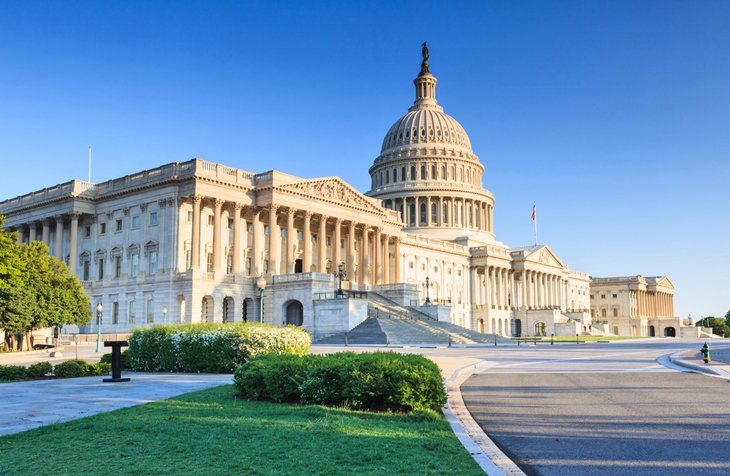
Recognized effectually the world as a symbol of the Usa, the Capitol is the seat of the House of Representatives and the Senate. The huge dome, based on the dome of St. Peter's in Rome, stands out above all other Washington buildings.
Like Washington itself, the building has grown over the years since the central portion was built betwixt 1793 and 1812. The last addition, in 1958-62, enlarged the main façade where presidents take the oath. On the other side, a marble terrace offers beautiful views over the mall and the city.
The interior is resplendent with frescoes, reliefs, and paintings, especially the rotunda under the swell cast-iron dome with a ceiling painting past Constantino Brumidi and huge paintings of scenes from American history on the walls. Beside it is the quondam Chamber of the House of Representatives, with statues of leading historical figures. The small-scale Senate Rotunda leads into the beautifully restored Old Senate Bedchamber, where the Senate met until 1859, and the Supreme Courtroom until 1935.
When free tours resume, they can be reserved online and begin at the visitor center on the lower floor, where there is an interesting exhibition on the building's history. Complimentary tours on weekday afternoons explore the ornate paintings on the walls and ceilings of the corridors in the Senate fly, designed by Brumidi betwixt 1857 and 1859. To visit the Senate or House in session, y'all need to contact your Senator or Representative for a pass; foreign visitors tin can arrange visits through the visitor heart.
Eastward of the Capitol are the Supreme Court Building; the Library of Congress; and Folger Shakespeare Library, home of the world'due south largest drove of the printed works of William Shakespeare.
The Capitol Loma neighborhood extends southeast, with the lively Eastern Market, a farmers market with craft vendors, as well.
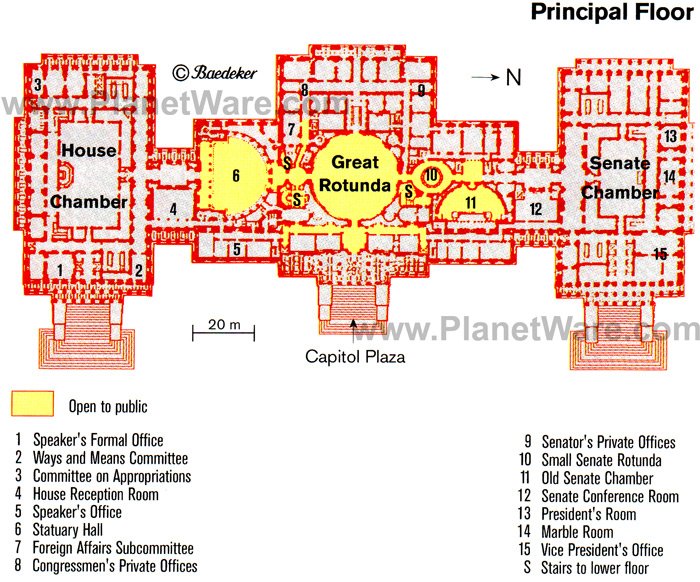
ii. The Lincoln Memorial
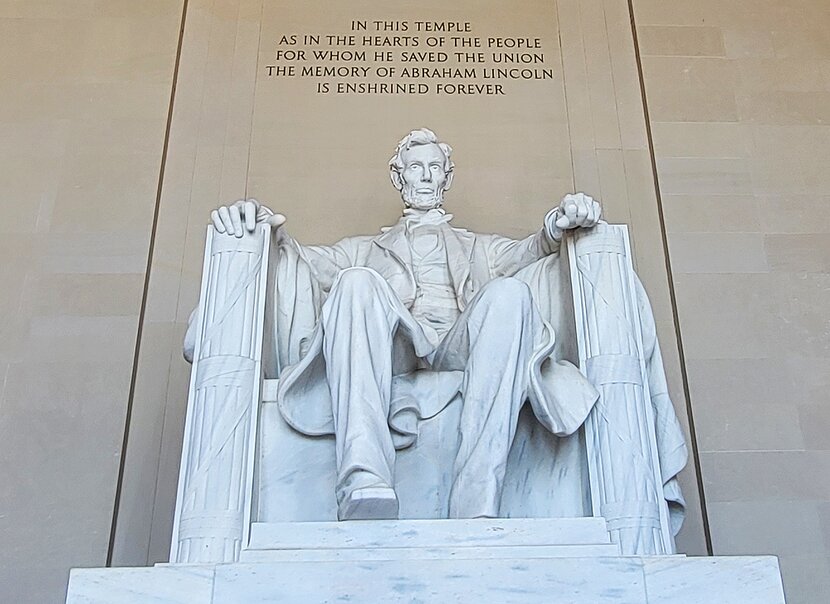
The best-loved of all Washington'south memorials, the Lincoln Memorial stands at the far end of the mall, separated from the Washington Monument by the Reflecting Pool. At its eye is a nineteen-foot marble statue of a seated and pensive President Abraham Lincoln surrounded by 36 columns, 1 for each of us that existed at the time of Lincoln'due south death. This is the near famous work designed by noted sculptor Daniel Chester French. Jules Guerin painted the murals on the inside walls, showing of import events in Lincoln's life.
Since its completion in 1922, the Lincoln Memorial has been the scene of a number of celebrated events. 1n 1939, when the all-white Daughters of the American Revolution (DAR) refused to allow historic African American singer Marian Anderson perform at a concert in nearby Constitution Hall, President Franklin Roosevelt and First Lady Eleanor Roosevelt arranged for her to requite an open up-air concert on the steps of the Lincoln Memorial, attended past 75,000 people and circulate to millions of radio listeners.
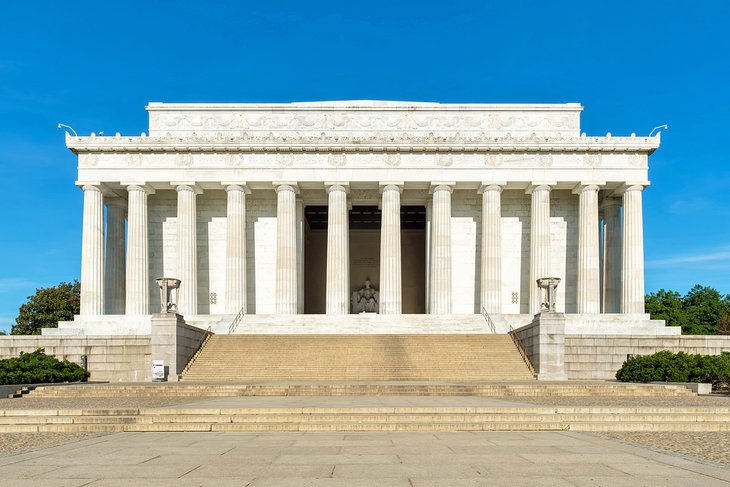
Martin Luther Rex Jr. delivered his famous "I have a dream..." speech from the memorial steps in 1963, once more making history here.
Visiting this and other Mall monuments is one of the favorite things to do in Washington, D.C. at nighttime. The monuments are all lighted, and many, similar the Lincoln Memorial, are open 24 hours. The statue of Lincoln is specially powerful lighted at night inside the darkened interior of the temple and framed by the floodlit white columns.
3. National Mall and Veterans Memorials
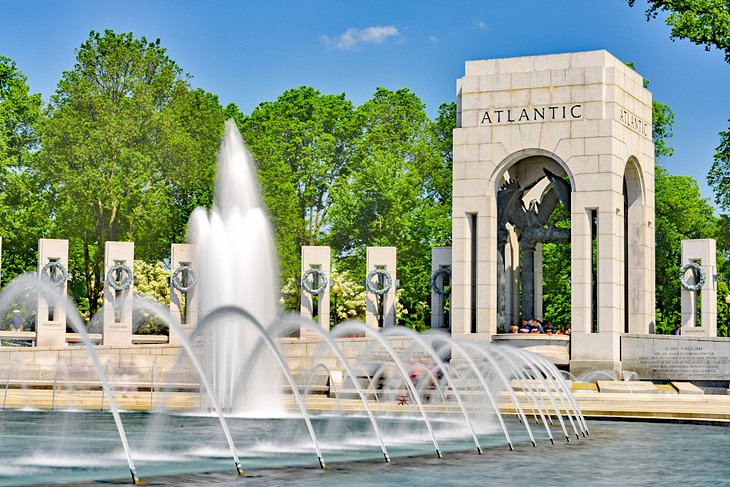
The spacious swath of lawns and pools that forms a broad greenbelt from the Capitol Edifice to the Lincoln Memorial is besides the site of many of Washington's landmark buildings and monuments. Well-nigh prominent at its centre indicate is the Washington Monument, and war memorials include those to veterans of Earth War II, the Korean War, and Vietnam.
The Vietnam Veterans Memorial, a poignant wall inscribed with the names of all American servicemen and women who lost their lives or are missing, is 1 of Washington's nigh visited memorials. The nearby Vietnam Women's Memorial has a bronze sculpture of three servicewomen helping a wounded soldier. The Korean War Veterans Memorial contains 19 steel sculptures of soldiers. The newest, American Veterans Disabled for Life Memorial was defended in 2014.
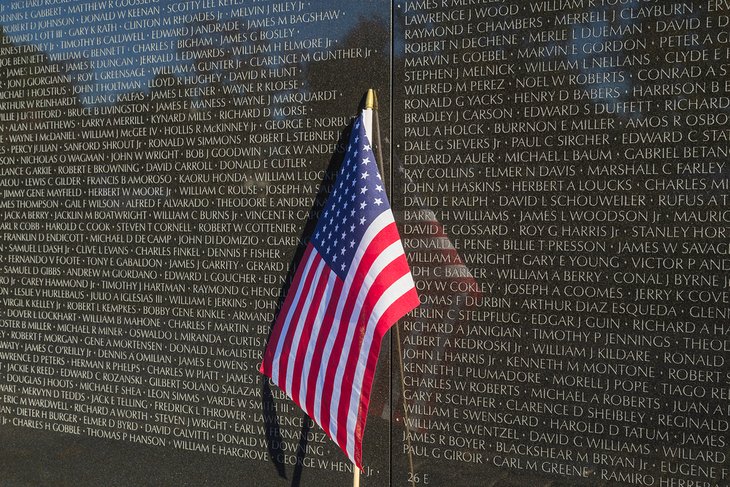
If you await at a Washington, D.C. attractions map, you'll find that many of them line the National Mall, then y'all're likely to spend a lot of time here. Along with providing a park for walking, running, and picnicking, the Mall is a place for celebrations and festivals. All-time known of these is the annual Independence Day celebration with fireworks around the Washington Monument.
Besides in July, the Smithsonian American Folk Life Festival fills the Mall with music, crafts, performances, storytelling, cultural programs, and nutrient from various regions around the state. The Smithsonian Kite Festival is held here in late March or early on April.
On summer evenings, you tin can often find military bands performing at venues along the Mall. The US Navy Band has concerts at the Capitol steps overlooking the Mall on Mondays and on Tuesdays at Navy Memorial. The US Air Forcefulness Band performs on the capitol steps on Tuesdays and at the Air Force Memorial on Fridays.
Location: Between Constitution Avenue and Independence Avenue, Washington, D.C.
4. The White House
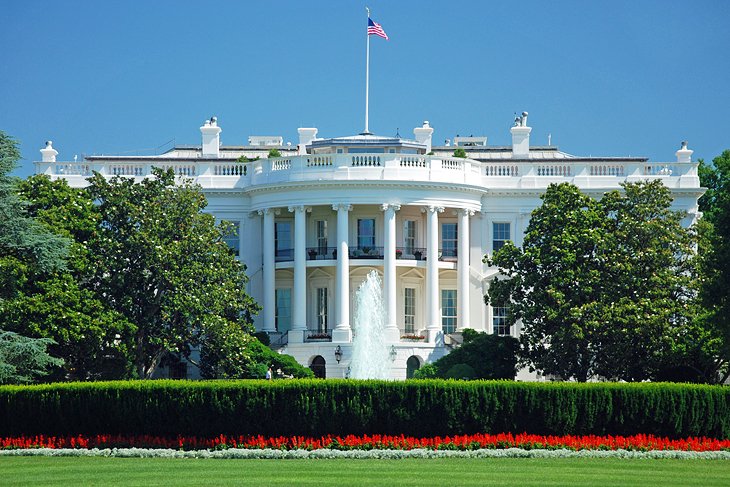
The White House is the official residence of the President of the Usa. The home of every president except George Washington, it was originally built by James Hoban in 1792, and afterward being burned down by British forces in 1814 was rebuilt in 1818.
Although tours of the interior that include the East, Bluish, Greenish, and Red Rooms; the Ballroom; and the State Dining Room must be reserved well in advance through your Congressional office or embassy, every tourist to Washington will want to encounter this iconic edifice, at least from the outside.
The costless White Firm Company Eye, a short distance abroad, has splendid interactive exhibits, which show details well-nigh the White House and the presidential families. It includes piece of furniture of past presidents, a model of the residence, historical changes, and videos with insights from presidents virtually their time living in that location.
The Ellipse, a 54-acre stretch of lawn stretching to Constitution Artery, hosts summertime concerts past the US Army Band. Next door to the White House are the elaborate 1833 Greek Revival Treasury Building and the 1871 Executive Part Building, 1 of the well-nigh hitting one-time government buildings in Washington. From Lafayette Foursquare, one of the urban center'south best-known, statues of Lafayette and others overlook the White House.
Address: 1600 Pennsylvania Avenue NW, Washington, D.C.
Official site: http://www.nps.gov/whho/index.htm
5. The Washington Monument
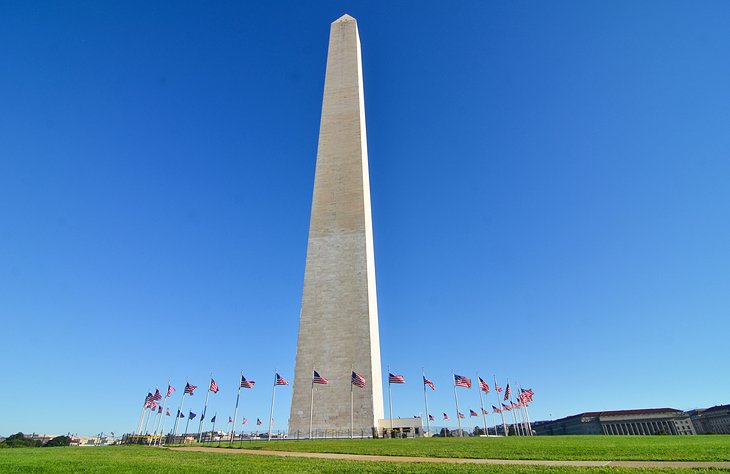
The 555-foot white shaft of the Washington Monument is a familiar icon of the National Mall, and a cute sight, particularly when mirrored in the long Reflecting Pool at its pes. Construction of the obelisk to award the nation'southward first president did not proceed smoothly. The program was canonical by Congress in 1783, but ground wasn't broken until 1848.
When the tower reached 156 feet in superlative in 1854, political wrangling and lack of funds stopped the project for several years, and the Civil War acquired farther suspension so that the tower was non capped until 1885, when it was finally completed by the Army Corps of Engineers.
You lot tin still meet the split up stages of its building by three changes in the color of its facing stones; inside are engraved stones from states, cities, strange countries, individuals, and civic groups, many of them donors who helped in its private funding stages. Y'all tin take an elevator to the very superlative for aerial views over the mall and much of Washington. The base of the monument is surrounded past a circle of 50 American Flags.
Address: 15th & Constitution Artery NW, Washington, D.C.
half-dozen. National Air and Space Museum
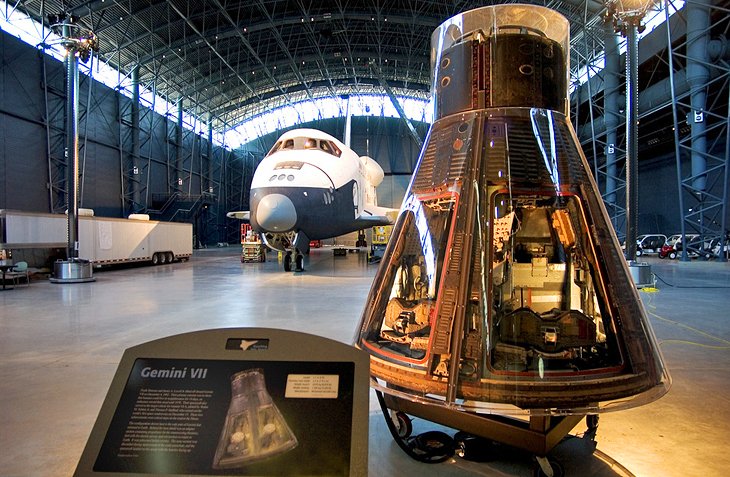
The National Air and Space Museum is 1 of the world's nigh popular museums, with a collection of history-making air and spacecraft that includes the original 1903 Wright Brothers Flyer and Charles Lindbergh'southward Spirit of St. Louis, the first plane to fly solo beyond the Atlantic Ocean.
More recent flight history is represented hither by the Apollo 11 command module, part of the showtime manned lunar landing mission. Permanent and irresolute exhibitions illustrate the science, history, and technology of aviation and space flight, covering topics like the use of air power in both world wars, the space race, flight pioneers, and up-to-the-minute flying and space technology.
Many of the exhibits are interactive, and all contain actual historical objects, such as a moon rock you tin impact. Non only do permanent exhibits illustrate history, they show the how and why of flying and space science, explaining how things fly, how jet engines work, and what keeps the International Space Station in orbit.
In addition to the exhibits, there is the Albert Einstein Planetarium, an IMAX theater, and the Public Observatory on the east terrace, where you tin examine lunar craters and see planets and other astronomical features through telescopes. Flight simulators (fee charged) allow kids and adults to fly combat missions with aerial maneuvers like 360-degree butt rolls or feel naval aviation in an F-xviii Super Hornet.
The museum is also the domicile of the Udvar-Hazy Heart in Chantilly, Virginia, side by side to Dulles Airport, has even more celebrated shipping and space exploration artifacts, including a Concorde and the infinite shuttle Discovery. You can sentry from observation walkways through the hangars where experts are restoring historic aircraft.
The Air and Space Museum is currently undergoing a seven-twelvemonth makeover that will transform not just the arrangement of 23 galleries, simply the manner it interprets the history and science of flight. During renovations, a number of the exhibits volition exist airtight, so if item exhibits are of special interest, y'all can consult the museum'due south website to find out if they are open.
Address: 600 Independence Artery SW, Washington, D.C.
Official site: www.nasm.si.edu
7. National Gallery of Art
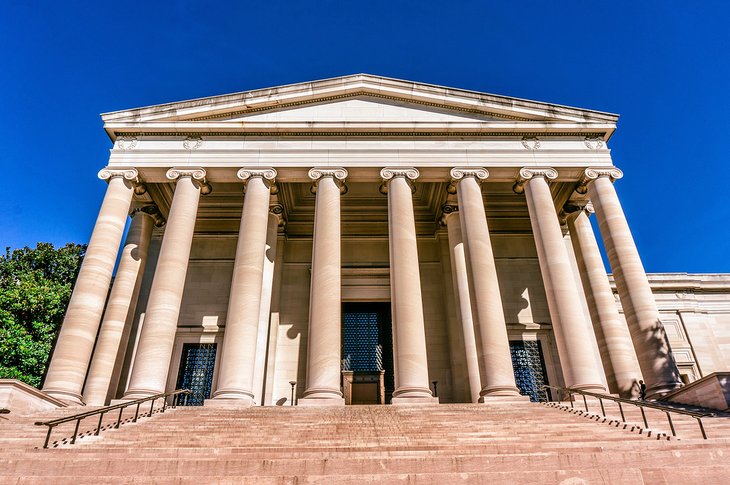
Housed in two dissever buildings connected by a tunnel, the National Gallery of Fine art is one of the world's premier art museums and 1 of the most pop in the U.S. Based on the sizable collection of financier and later on Treasury Secretary Andrew Mellon, its large and diverse collection includes masterpieces of European and American paintings, sculpture, and decorative arts.
Frequent temporary exhibitions add to this outstanding permanent collection to highlight arts from cultures around the globe. Among the highlights is Ginevra de Benci, the only Da Vinci painting in any American museum. Others include works by major French Impressionists - Monet, Degas, and Renoir -- and other masterpieces by Rembrandt, El Greco, and Vermeer.
The newer East Wing features sculptures by Henry Moore, a mobile by Alexander Calder, and other modernistic works. Free concerts are held at the National Gallery on Sunday evenings from fall through jump.
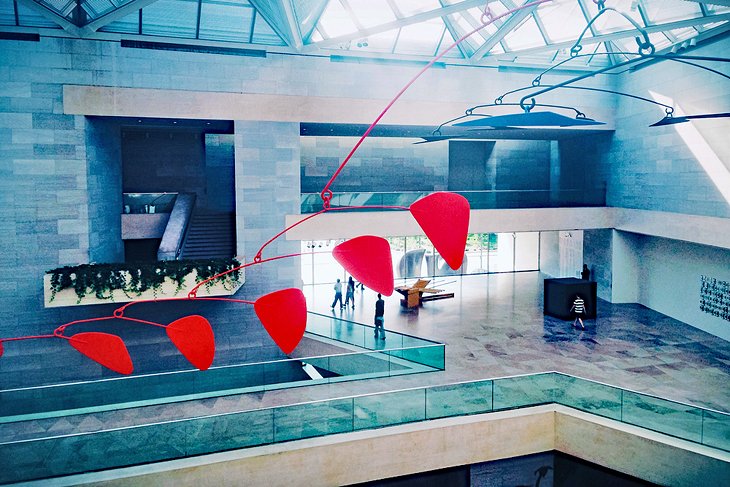
Also role of the Smithsonian Institution and located on the mall are the 2 museums that comprise the National Museum of Asian Art. These are the Freer Gallery of Art and the Arthur Grand. Sackler Gallery, which houses more than 1,000 pieces, principally Chinese jade and statuary, Chinese paintings and lacquerware, and ancient Near Eastern ceramics and metalware.
The Freer collection includes nigh xxx,000 pieces of Asian artworks, including Buddhist sculptures and Persian manuscripts, 1 of the most extensive collections in the globe. The Freer also features 19th-century and early 20th-century American art, most notably a large collection of work by James McNeill Whistler.
The drum-shaped Hirshhorn Museum and Sculpture Garden traces the history of mod fine art from the mid-1800s, through more 12,000 pieces of fine art and sculpture. I of the highlights of the garden is Rodin's Burghers of Calais.
The National Museum of African Fine art displays thousands of objects representing the diverse artistic styles throughout the African continent, including sculptures, masks, costumes, household objects, and ceramics. All of these Smithsonian museums are amidst the many costless things to do in Washington, D.C.
Accost: 600 Constitution Artery NW, Washington, D.C.
Official site: www.nga.gov
viii. United States Holocaust Memorial Museum
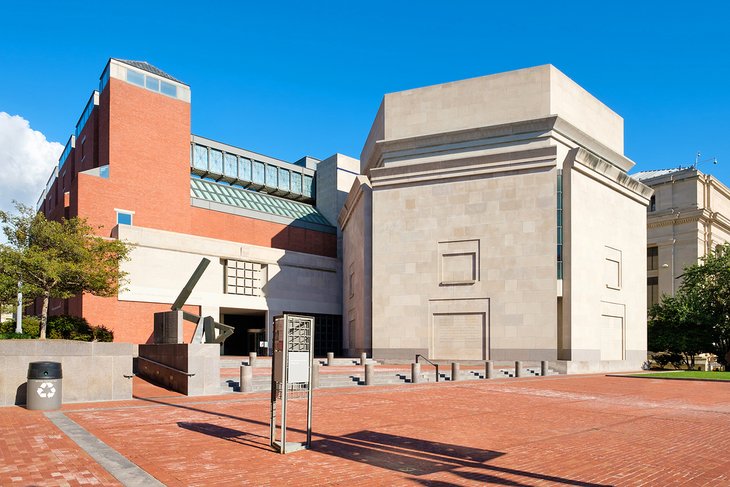
Near the Smithsonian museums, the United States Holocaust Memorial Museum documents, studies, and interprets the history of the Holocaust with the dual purpose of memorializing the victims and helping the earth to face hatred and prevent genocide.
Permanent exhibits examine the rise of the Nazis and the Aryan credo, the ghettos, key events such as Kristallnacht, the concentration camps, and the Nazi atrocities. An exhibit on Americans and the Holocaust examines US reaction to Nazis, the state of war, and genocide, while some other features personal accounts by US soldiers and citizens who witnessed the show of Nazi atrocities.
The presentations draw on the enormous collections of more than 12,750 artifacts, 85,000 historical photographs, 9,000 oral history testimonies, as well equally archival footage and records of survivors and their families. A visit to the museum is a sobering feel.
Accost: 100 Raoul Wallenberg Pl SW, Washington, D.C.
Official site: https://www.ushmm.org
9. Library of Congress
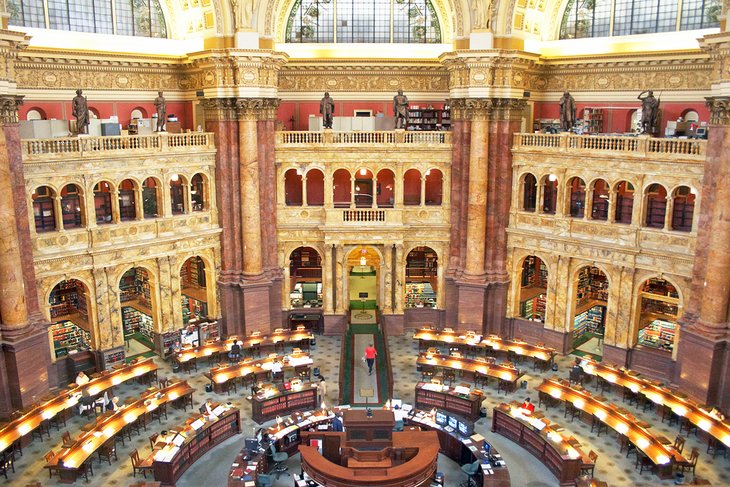
An hole-and-corner passage with historical exhibits leads from the Capitol Building to ane of Washington'south little-known places to visit, the Library of Congress. It's the world's largest library, modeled on the Opera Business firm in Paris. You can visit portions on your ain, merely free tours disembalm even more of its beautiful interior.
Displayed here are one of the three surviving complete Gutenberg Bibles, an before hand-printed Bible, Thomas Jefferson'southward typhoon of the Declaration of Independence, Jefferson'due south personal library, and galleries filled with exhibits focusing on topics as varied as the musical careers of the Gershwin brothers and the piece of work of editorial cartoonists and graphic artists.
Address: Capitol Hill, Washington, D.C.
Official site: https://world wide web.aoc.gov/
10. National Museum of Natural History
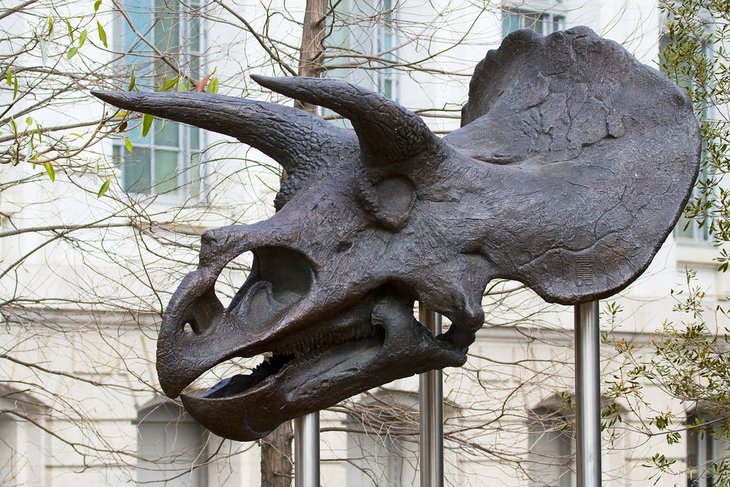
One of the virtually popular things to do with children in Washington, the Museum of Natural History explores the natural globe with permanent and changing exhibits to interest all ages. Favorite exhibits include the renowned Hope Diamond and the dazzling collection of gems and minerals around it, and Ocean Hall with its stunning underwater photography and replica of a 45-pes North Atlantic Correct Whale.
The Hall of Human Origins, which follows human evolution over half-dozen million years in response to a changing earth. Children volition especially similar the dinosaur exhibits and the interactive Discovery Room where they tin touch and play with various artifacts.
Address: Constitution Avenue NW, Washington, D.C.
Official site: http://world wide web.si.edu/Museums/natural-history-museum
11. National Museum of American History
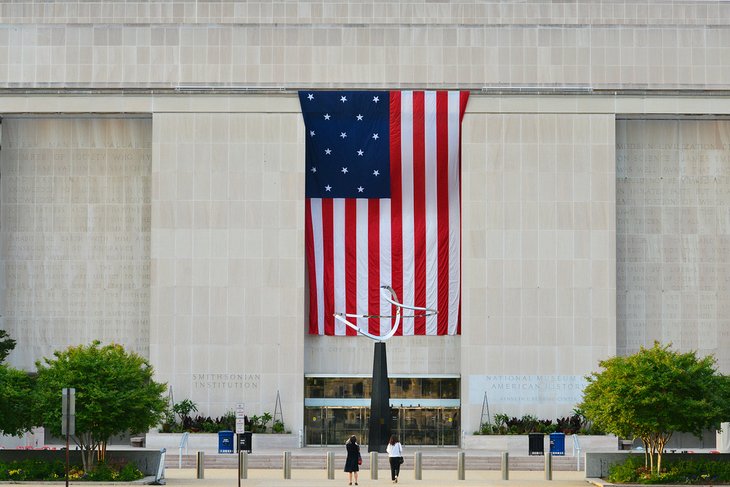
One of the most popular of the Smithsonian'south many museums that line the mall, The National Museum of American History traces the political, cultural, scientific, and technological history of the U.South. since the Revolution. Information technology displays of import pieces of Americana, including Thomas Jefferson's desk, i of Edison's light bulbs, and the original flag that inspired Francis Scott Key to write the words to The Star Spangled Imprint.
But beyond these treasured national artifacts, exhibits besides examine how people lived, what they ate, where they worked, how they played, what they wore, how they traveled, how they worshiped, and how they governed themselves.
Illustrating these multiple themes are artifacts that include everything from gowns, work by Kickoff Ladies, and Julia Kid's complete kitchen to the Muppets and the bodily blood-red slippers Judy Garland wore in the movie Magician of Oz. With all the historical things to do in Washington D.C., you might think your family has had enough history. Just this engaging museum houses some fascinating exhibits and artifacts of our collective by that will entreatment to all ages.
Address: 14th Street NW at Constitution Avenue NW, Washington, D.C.
Official site: http://americanhistory.si.edu
12. National Museum of African American History and Culture
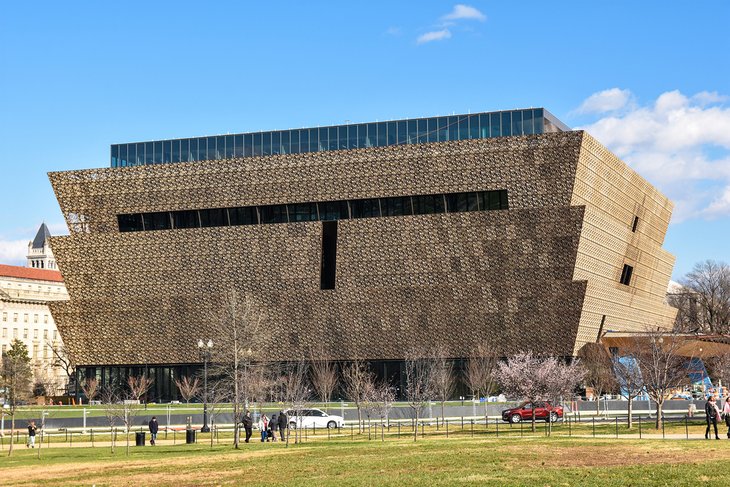
Focusing on themes of history, culture, and community, the newest of the Smithsonian museums explores changing definitions of American citizenship and equality, at the same fourth dimension highlighting African American culture and that of the entire African diaspora.
Various themes are covered in irresolute exhibits, which center on themes such every bit African American food traditions and chefs, the influence of African American sports stars on the breakup of segregation, and African craftsmanship.
Celebrated artifacts on brandish include a section of the original Woolworth lunch counter that was the scene of the Greensboro, Due north.C. demonstration in 1960, and the aircraft known as the "Spirit of Tuskegee." In World War Two, it was used to train African American airmen in the Regular army Air Forces, men whose work helped trigger the desegregation of the military.
Address: National Mall at Constitution Avenue, N.W., between twelfth and 14th Streets
Official site: https://nmaahc.si.edu/
13. Jefferson Memorial and Tidal Bowl
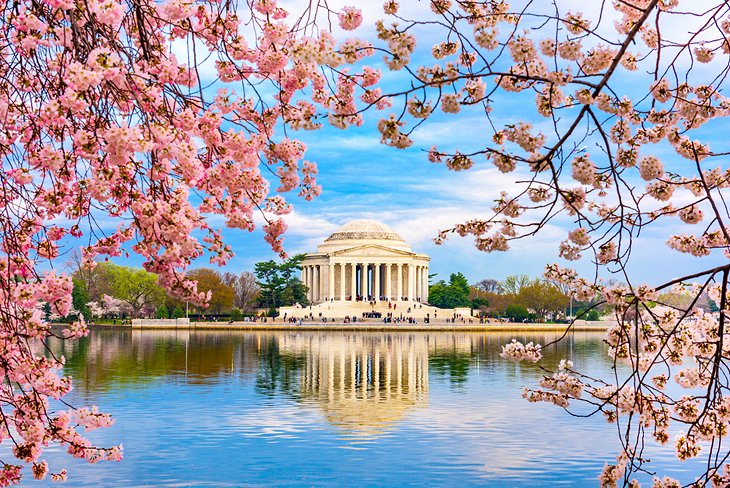
The design for the domed white memorial to Thomas Jefferson, the third US president, is based on the Roman Pantheon, its low dome supported past 54 Ionic columns. Inside, appearing in a dramatic silhouette through the columns, is a 19-foot statue of a continuing Jefferson, and effectually are engraved excerpts of the Declaration of Independence and other writings.
The monument stands alone at the far end of the Tidal Pool, which reflects the monument in its surface, and all around the border of the h2o are cherry trees, a souvenir from Japan. These are i of Washington's greatest attractions when they bloom each spring, surrounding the basin with a cloud of pinkish flowers and celebrated with the Scarlet Blossom Festival.
Forth the Blood-red Tree Walk around the Tidal Basin, the Franklin Delano Roosevelt Memorial reflects twelve years of American History through four outdoor rooms. Each one is devoted to one of FDR's terms of office as he guided the country through the Great Depression and Earth State of war II. Unveiled in 2011, the 30-pes-high Martin Luther King Jr. Memorial is the newest forth the Tidal Basin.
Address: 900 Ohio Bulldoze SW, Washington, D.C.
14. The John F. Kennedy Heart for the Performing Arts
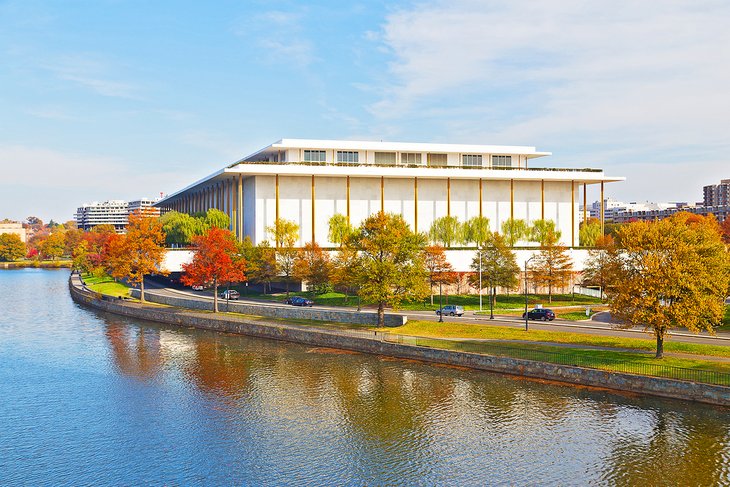
Opened in 1971 and named in memory of President John F. Kennedy, the National Cultural Eye overlooks the Potomac River in a land-of-the-art building designed by architect Edward Durell Stone. Information technology is home to the National Symphony Orchestra, which hosts some of the globe'southward greatest guest artists each year, and the Washington National Opera, one of the nation'due south leading opera companies.
Its three main stages and several smaller stages present over two,200 performing arts shows and events each year, virtually 400 of which are free. These represent all types of music and theater, both classical and gimmicky.
Joining the Los Angeles Music Center and Lincoln Middle in New York every bit one of the three most important venues in the United States, the Kennedy Heart is a major finish for visiting overseas opera, trip the light fantastic toe, and drama companies on tour.
Address: 2700 F Street NW, Washington, D.C.
Official site: www.kennedy-middle.org
15. National Zoological Park
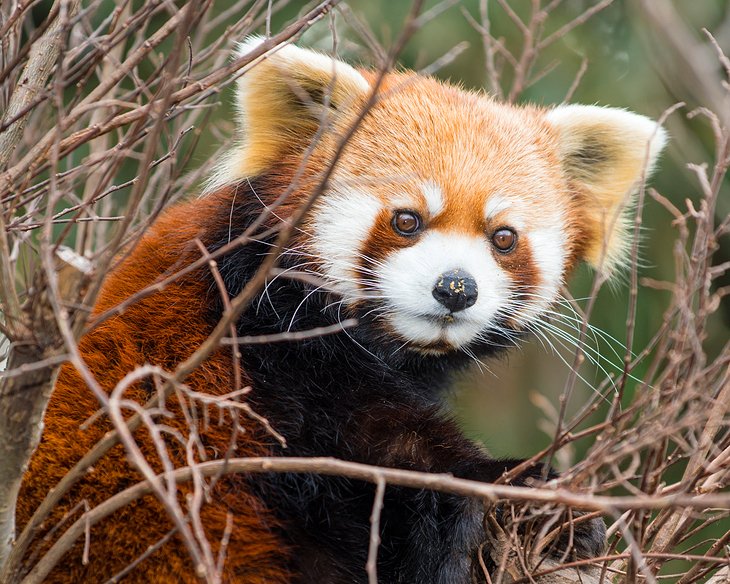
The National Zoo is another part of the Smithsonian, where nigh 2,000 different animals, birds, and reptiles live in habitats replicating as closely as possible their natural environments. Of the several hundred species represented here, near a quarter are endangered. This is one of the world's all-time zoos, not only for the quality of the visitor experience, but for its leadership in areas of animal care and sustainability.
By far the nigh popular animals here are the giant pandas, part of a major initiative that began in 1972 with the arrival of Hsing Hsing from the Communist china. Other zoo highlights are crimson pandas, Sumatran tigers, western lowland gorillas, Asian elephants, cheetahs, white-naped cranes, and North Island brown kiwis.
In the Amazonia showroom, you can glimpse the colorful underwater life of the Amazon, where 1 of the world's largest freshwater fish swims beneath a living tropical woods.
Along with the cheetahs at the Cheetah Conservation Station, you can encounter Grevy's zebras, dama gazelles, vultures, and red river hogs, and at the highly popular Elephant Trails, you can see the multigenerational herd and learn about the elephants' life at the zoo and in the wild.
Cheque the twenty-four hour period's schedule for feeding times, demonstrations, educational games, and talks. As you lot might expect, this is one of Washington'south favorite places to visit for children.
Address: 3001 Connecticut Avenue NW, Washington, D.C.
Official site: http://nationalzoo.si.edu
16. National Archives
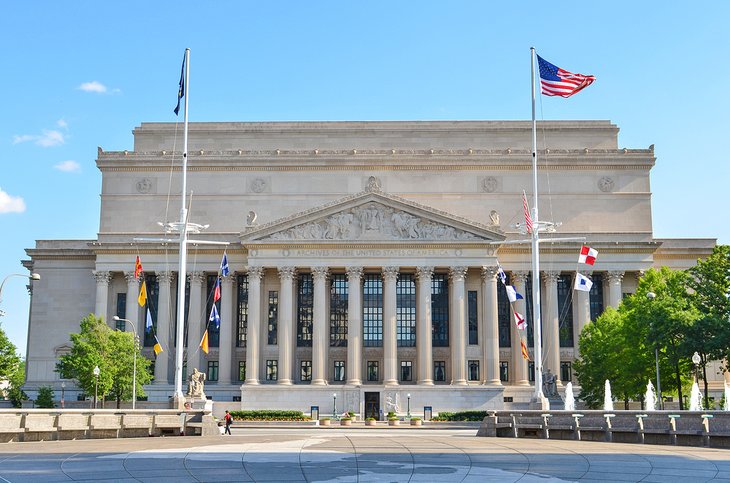
The National Athenaeum holds permanent records of the U.Southward. Congress, the U.S. Supreme Court, District of Columbia courts, and some federal agencies, too as pre-Globe War I armed services service records for U.S. Army and Amalgamated veterans, and pre-1940 vessel and station logbooks for the U.Due south. Navy.
The records are open to researchers, and in the Rotunda, you can meet the Declaration of Independence, Constitution, and Bill of Rights. Exhibition galleries characteristic a 1297 Magna Carta and a changing grouping of other historically pregnant documents. An exhibit, Rightfully Hers: American Women and the Vote, includes documents from the suffrage movement, and in other areas are interactive exhibits and hands-on activities for all ages.
Address: 701 Pennsylvania Avenue NW, Washington, D.C.
Official site: https://museum.archives.gov
17. International Spy Museum
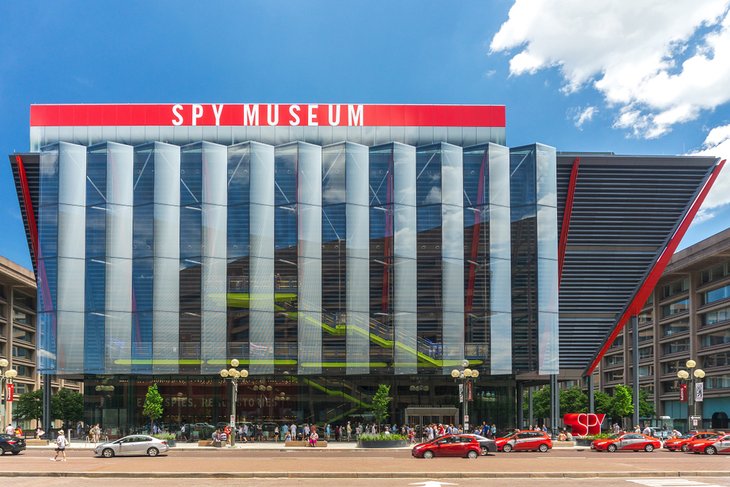
The place for 007 wannabes, the museum covers the techniques, technology, history, and contemporary part of espionage. Many of the exhibits are interactive, and throughout the building are actual examples of existent espionage equipment (including a poisonous substance dart umbrella designed by the KGB), from declassified hardware and captured equipment to movie props used in the James Bond series.
Photographs, sound visual programs, and special effects combine to give a movie of strategies and methods behind secret espionage missions. The collections include historic spy artifacts from the Revolution and Civil War, along with a wealth of ingeniously concealed and disguised cameras and weapons, even the famous Enigma cipher machine that broke the Nazi codes in World War II.
The pinnacle floor is dedicated to real life spies Aldrich Ames, Robert Hanson, and John Walker, detailing the actual methods and tools they used to spy on the United States, with videos describing how spies were caught. The lower floor moves from fact to fiction, filled with data and actual props used in James Bond movies.
Highlighting these is the Aston Martin DB5 that showtime appeared in the 1964 flick Goldfinger, equipped with machine guns, oil jets, a dashboard radar screen, ejector seat, tire slashers, bulletproof shield, and rotating license plate. The car actually inspired intelligence agencies to add similar features to their own vehicles.
Address: 700 L'Enfant Plaza, SW; Washington, D.C.
Official site: www.spymuseum.org
18. Arlington National Cemetery
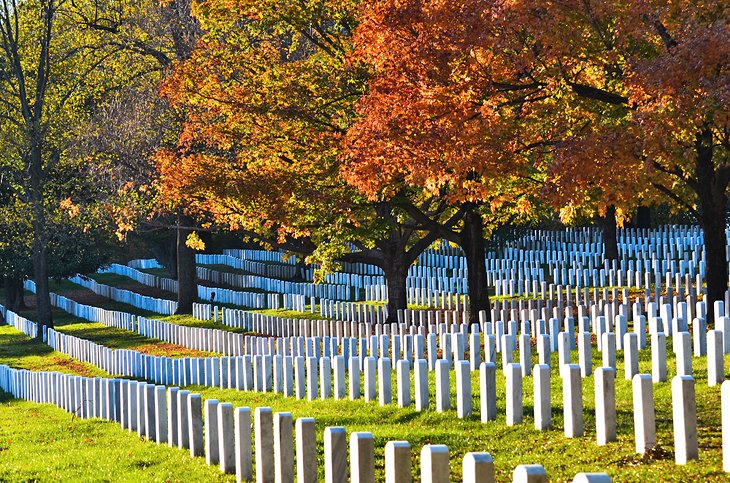
On a hillside overlooking the urban center from across the Potomac River, Arlington National Cemetery is filled with memorials to American history and the men and women who were part of information technology. Its best-known landmarks are the Tomb of the Unknown Soldier, President John F. Kennedy's gravesite, and the U.S. Marine Corps War Memorial depicting the raising of the flag on Iwo Jima in Earth State of war II. The Welcome Centre has maps, information (including the locations of specific graves), exhibits telling the story of Arlington National Cemetery and its monuments.
Among these are memorials to nurses, Iran Rescue Mission casualties, and various battles and groups, including one at the graves of Lt. Cmdr. Roger B. Chaffee and Lt. Col. Virgil I. "Gus" Grissom, who were killed in a fire aboard their Apollo spacecraft. Some other commemorates the vii Challenger astronauts.
In a solemn and impressive ceremony, the guard at the Tomb of the Unknown Soldier is changed every 60 minutes on the 60 minutes Oct i to March 31, and every half hr April 1 through September 30. Although the cemetery is not right in the metropolis, both the Washington Metropolitan Area Transit Authority's Metrorail system and Metrobus take stops shut to the gate.
Official site: https://world wide web.arlingtoncemetery.mil
19. Washington National Cathedral
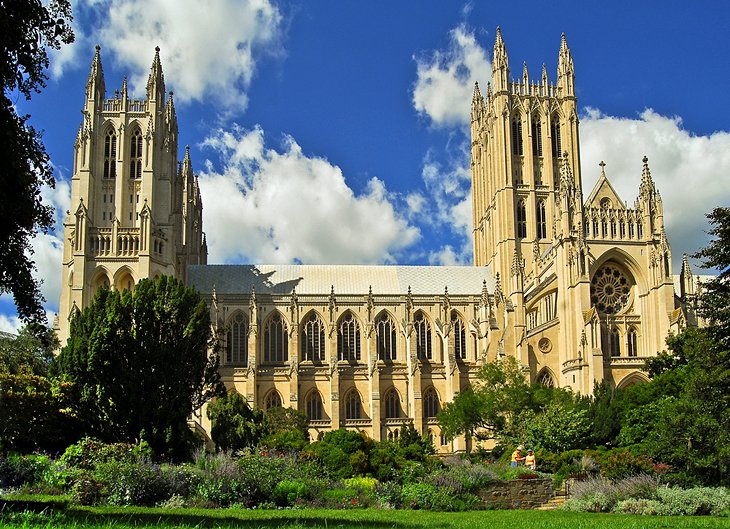
The English language-style, Neo-Gothic National Cathedral, 1 of the world's largest cathedrals, took 83 years to build, from 1907 to 1990. It follows the Gothic building manner and techniques, with flight buttresses and solid masonry construction of Indiana limestone. Throughout the cathedral are creative details to see, from its stained-drinking glass windows to the paw-embroidered kneelers that commemorate war heroes and celebrated events.
Special tours, reserved in advance, explore hidden parts of the building and its art; families should enquire for the brochure Explore the Cathedral with Children for a scavenger chase to discover wrought-atomic number 26 animals, tiny carvings, and gargoyles. Be certain to look for the gargoyle of Darth Vader high up on the northwest tower.
The cathedral is the burial place of President Woodrow Wilson and Helen Keller, and land funerals for Presidents Eisenhower, Reagan, and Ford took place here. The pinnacle of the 300-pes primal tower is the highest betoken in Washington.
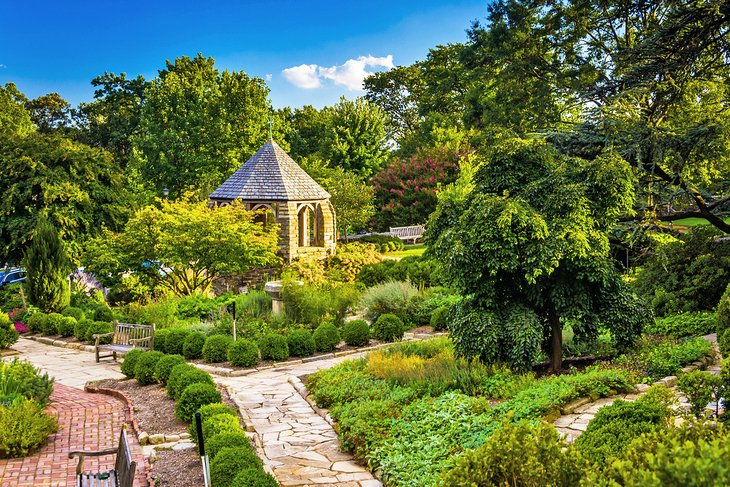
The Bishop's Garden, on the south side of the cathedral, includes plants found in medieval gardens, plants mentioned in the Bible, and others native to the area, forth with a fish pond. The 59-acre Cathedral Close, designed past the eminent landscape architect Frederick Police force Olmsted, Jr in the early on 20th century, is an urban haven modeled on the walled grounds of medieval cathedrals.
Carillon recitals are held each Sabbatum at 12:30pm, and the peal bells are rung on Tuesday evenings from 7 to 9pm and afterwards Sunday services. On Mondays and Wednesdays at 12:30pm, a cathedral organist discusses the Great Organ hither, followed past a mini-recital.
Address: Massachusetts & Wisconsin Avenues NW, Washington, D.C.
Official site: www.cathedral.org
xx. Georgetown Historic District
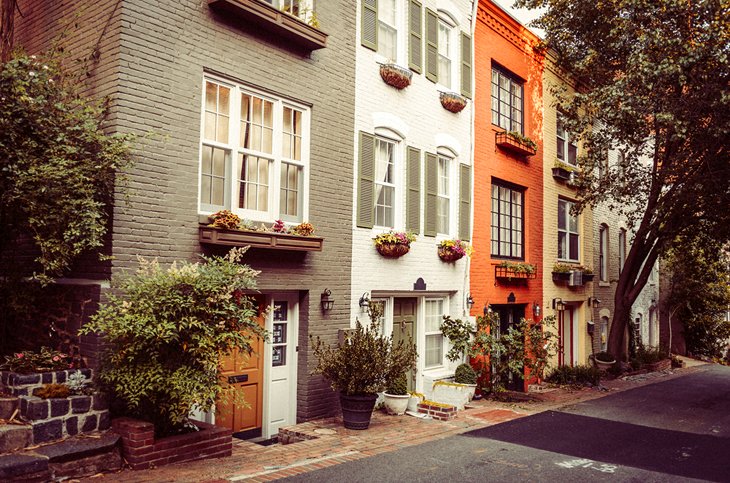
The neighborhood from 27th to 37th Streets, between Rock Creek Park and Chiliad Street NW, is the city's oldest, with origins in the early 1700s, earlier Washington itself. Georgetown University, the nation'due south oldest Roman Catholic and Jesuit College, is located hither.
Today, Georgetown'due south tidy streets of historic homes and its bazaar shops, cafés, restaurants, and small museums brand information technology a pop respite from lines at the mall attractions. The C&O Canal, the 184-mile waterway paralleling the Potomac River, begins here, and its towpath is a favorite place for walking and cycling.
Dumbarton Oaks is a 16-acre manor with formal gardens and a valuable Byzantine and Christian art drove. Federal period Dumbarton Business firm features Federal-style article of furniture, paintings, textiles, silver, and ceramics, and is home to 1 of 5 original known copies of the Articles of Confederation.
Tudor Identify is an early 19th-century mansion built by Martha Washington'due south granddaughter, Martha Custis Peter, and her husband. Items from George and Martha Washington's Mount Vernon home are shown here, and the Federal-period gardens comprise plants and trees from the early 19th century. The Kreeger Museum displays a wide collection of fine art from the 1850s to the 1970s including paintings by Monet, Renoir, Sisley, Chagall, Gauguin, and Picasso.
If yous're looking for places to eat in Washington or things to practise at night, this is 1 of the places to visit. The neighborhood is filled with restaurants and cafes, forth with live music venues.
21. Smithsonian American Art Museum and National Portrait Gallery
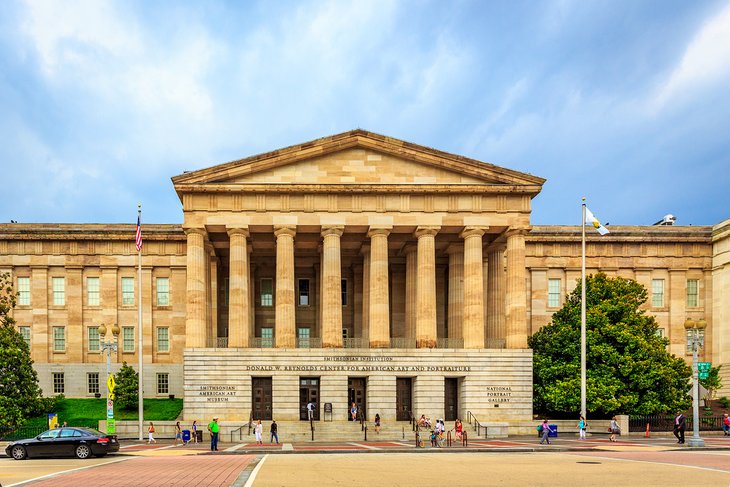
Sharing the celebrated Old Patent Role Building with the National Portrait Gallery, the Smithsonian American Art Museum holds one of the world's largest and most inclusive collections of American art, representing more than than seven,000 artists from the colonial era to the present.
The collections record the wonder of artists capturing the dazzler of American landscapes as the nation expanded westward, and the irresolute face of American cities and towns. Special collections correspond works past more than 200 African American artists, collections of Latinex works, an outstanding array of contemporary American craft and folk arts.
The National Portrait Gallery focuses on famous Americans, from the time of the showtime colonies to present day leaders and important public figures, including the only consummate collection of presidential portraits outside of the White House.
Address: eighth and G Streets NW, Washington, D.C.
Official sites:
- https://americanart.si.edu/fine art
- https://npg.si.edu/
22. U.Southward. Botanic Garden
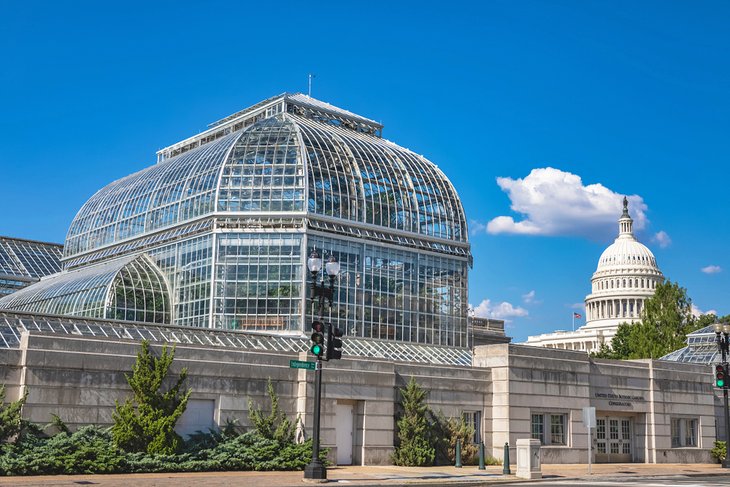
At the pes of Capitol Hill, the U.South. Botanic Garden is an oasis of tropical gardens in the eye of the city. Surrounded by outdoor gardens, the huge glasshouse is the hub of a museum of living plants. Permanent interior exhibits create environments for plants at dwelling house everywhere from the desert to rainforests, while outside is a showcase of plants that thrive in the Eye Atlantic states.
The greenhouse contains two courtyard gardens and 10 garden rooms, and the outside displays include a pollinator garden, rose garden, kitchen garden, and h2o garden. In that location's always something in bloom, and benches in the vast conservatory invite a stop to enjoy the fragrances and the lush green surroundings.
Address: 100 Maryland Avenue, SW, Washington, D.C.
Official site: https://www.usbg.gov/
Where to Stay in Washington, D.C. for Sightseeing
Pennsylvania Avenue connects the White House and Capitol Building, while alongside it, the National Mall stretches past the Smithsonian museums to the Washington Monument and Lincoln Memorial. Most of the summit tourist attractions are nearly these, so prime number locations heart betwixt Capitol Hill and Foggy Bottom, s of Dupont Circle. For a mannerly historic neighborhood, with public send to attractions, consider Georgetown. These highly-rated hotels in Washington are handy for visitors:
Luxury Hotels:
- The Jefferson at Dupont Circle, an easy stroll from the White House and National Mall, is a D.C. landmark, which lost none of its historic elegance in the recent renovations.
- Another gracious Washington institution, The Hay-Adams overlooks Lafayette Park and the White House and welcomes children with special activities.
- Within walking distance of Georgetown'southward celebrated streets of restaurants and shops, Fairmont Washington D.C. Georgetown is near Ford'southward Theatre and an like shooting fish in a barrel walk to the Mall.
Mid-Range Hotels:
- Nigh the White House, Metro, and trolley stops and an like shooting fish in a barrel walk to the Smithsonian museums, Hampton Inn Washington, D.C./White House has free breakfast and an indoor puddle.
- In a tranquility neighborhood, a cake from the metro line and close to the Capitol, Library of Congress, and Marriage Station, Capitol Colina Hotel offers gratuitous breakfasts and a fettle center.
- Near DuPont Circle and a brusque walk to Georgetown art galleries, theaters, and restaurants, Royal Sonesta Washington DC has a pool, fettle centre, and costless parking nearby.
Budget Hotels:
- Most K Street and five minutes from the Foggy Lesser Metro, West Cease Washington DC Tapestry Collection by Hilton has kitchenettes and complimentary breakfast, within walking distance of the White House.
- Also in the Foggy Bottom neighborhood, Hyatt Place Washington DC/Georgetown/Westward Stop is almost equidistant from the National Mall (a 20-minute walk) and Georgetown (15 minutes). There'due south an indoor pool, and breakfast is complimentary.
- Close to Union Station and a brusk walk from the Capitol Edifice and Library of Congress, Hyatt Regency Washington on Capitol Hill is near the finish for the free DC Circulator bus, accessing downtown and the National Mall museums and memorials.
Tips and Tours: How to Make the Most of Your Visit to Washington, D.C.
Sightseeing by Twenty-four hours:
- Washington, D.C. has so many famous sites that it's difficult to continue rail of all there is to see and do. One of the best means to explore this urban center is on a classic Large Motorbus Hop-on Hop-off Bout , seeing the sites from an open-top carmine bus and getting on and off wherever you choose.
Sightseeing by Night:
- At night, Washington is transformed as the floodlights are beamed up the monuments, giving them a completely unlike look from their daytime appearance. The Washington, D.C. Monuments by Moonlight Night Trolley Tour is a ii.v- hour guided tour that provides an easy style to run across the city at night.
Sightseeing past Bike:
- Agile travelers volition enjoy the Washington D.C. Monuments Wheel Tour to visit the Washington Monument, Vietnam Veterans Memorial, Lincoln Memorial, and Jefferson Memorial on a three-hour ride. Hybrid bikes and the relatively level terrain make this suitable fifty-fifty for those who are not avid cyclists. As many places to visit accept security checkpoints and do non let backpacks, it is wise to acquit as little as possible while touring.
More Related Articles on PlanetWare.com
Source: https://www.planetware.com/tourist-attractions/district-of-columbia-usdc.htm
0 Response to "Freer and Sackler Galleries of Asian Art Mount Vernon"
Post a Comment